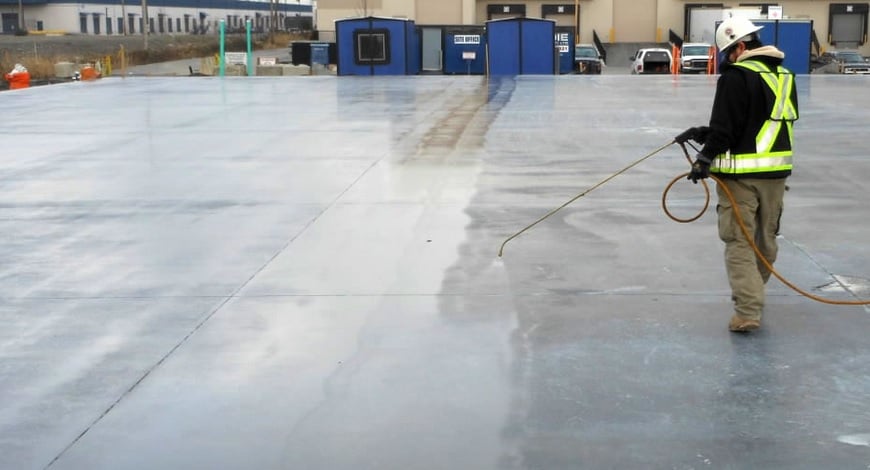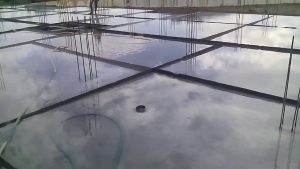
Concrete Curing Techniques
Why Cure Concrete?
Curing involves maintaining the concrete moisture content and temperature at so that it can develop and achieve the designed properties of the mixture. The process begins immediately after the concrete is poured and is complete once the concrete has developed the desired strength and durability.
If the concrete does not retain an adequate supply of moisture during this process the cement mixture cannot react properly to acquire its full potential properties. This hydration process is considered a vital part of construction. Studies have shown that concrete in a dry environment can lose as much as 50% of its potential strength compared to the same concrete mixture that’s gone through moist curation.
Benefits of Curing
Predictable Strength Gain
Temperature is an important factor during the curing process as it affects the rate the concrete will remain hydrated, hence affects the overall strength development. If the concrete is poured and left under high-temperature conditions it will gain strength faster but will have overall reduced strength compared to concrete placed in colder weather. However, in cold weather, while it will be stronger in the long term, it may delay further construction as it takes longer to gain this strength.
Improved Durability
It has been shown that the surface of cured concrete is tougher than non-cured and is able to better withstand surface wear and abrasion. The curing process also eventually makes the concrete more water-tight, preventing moisture and water-borne chemicals from being able to enter the material, therefore increasing the durability of the concrete and ultimately increasing its service life.
Better serviceability and appearance
Proper curing as mentioned previously has a tougher surface, meaning less abrasion can occur and reduces crazing, dusting, and scaling. This means the concrete will be far more aesthetically pleasing as well as able to last far longer.
Curing Methods
Continuously Adding Moisture
One type of method is preventing moisture loss by continuously wetting the exposed surface of the concrete to ensure it is continuously kept moist. For this method, it is suggested that the water should be no more than 5°C cooler than the concrete surface and should not be used at all if the air temperature is close to or below freezing. If cold water is used on warm concrete it can cause the concrete to crack. It is also important that the surface must be kept continuously wet and not be subdued to a wet and dry cycling. If the surface becomes dry during curing it may cause crazing and cracking in the concrete. Some examples of this method include;

Concrete Slabs Curing – Ponding Method
Ponding
If the concrete surface is flat, or near flat, such as a floor, pavement etc. A ‘dam’ or ‘dike’ can be erected around the edge of the slab and the water can then be added to create a shallow ‘pond’. During the curing process the pond will need to be checked to ensure it does not empty due to evaporation or leaks. This method is quick and inexpensive.
Sprinkling or fog curing
An efficient method of supplying additional moisture during curing is using a fine spray or fog of water. During hotter weather, this method also helps to reduce the concrete temperature. While the sprinkler can be set using an intermittent timer, it must keep the concrete permanently wet. This method consequently requires a major water supply which can be wasteful. Other downsides to the sprinkler system include the ability to be highly affected by windy conditions and difficult to ensure all the concrete surface is kept moist. Therefore, other methods are preferable in most circumstances.
Wet coverings
Another technique for this time of curing process is adding coverings to the concrete which hold moisture. These types of coverings can be anything from hessian fabrics, straw or even mulch like materials like sand and sawdust. It is of utmost importance that if this method is being utilised that the material selected for use covers the entire surface area and should be placed as soon as the concrete has hardened sufficiently enough to prevent surface damage. The coverings cannot be allowed to dry out during the curing process as they may then draw moisture from the concrete, having the opposite effect necessary. This type of method is particularly useful on vertical surfaces as they can assist with evenly distributing the water over the surface and simultaneously reduce the rate of surface evaporation. Prewashing of materials is highly suggested to avoid possible staining of the concrete surface and should be moistened prior to placing on the concrete surface to avoid wicking of moisture.
Moisture retaining materials
Membrane-forming curing compounds
Specifically designed curing compounds are one of the most efficient and cost-effective means of curing concrete. They are usually sprayed directly onto the concrete surface and then left to dry and form a relatively impermeable membrane that reduces moisture loss. It should be noted however that care should be taken when selecting a suitable compound. Some products may affect the bond between the concrete and subsequent surface treatments. For example, it may prevent adhesion of flooring products, such as tiles, onto the concrete.
Formwork
Another efficient and cost-effective method of concrete curing is simply leaving formwork in place. In hotter weather it may be necessary to moisten timber formwork to prevent it drying out during the process. Any exposed concrete surfaces should also be either covered in plastic sheeting or kept moist by other means.

Dual Concrete Curing Method – Plastic Sheets over Burlap Sack
Plastic sheeting
Simply covering the concrete is plastic sheeting or a similar material, can work as an effective barrier against water loss. These sheets must be securely kept in place and protected from damage to ensure they remain effective during the entire curing process. On flat surfaces, such as pavements, they should extend behind the edges of the slab, preferably at least twice the thickness of the slab. Alternatively, the sheet can be turned down over the edge of the slab and sealed. Like other covering methods, it should be applied over the concrete surface as soon as possible, without marring the concrete surface.
Internal curing compounds
Additives to the concrete mixture itself to help with the curing process are called ‘Internal curing compounds’. These compounds are a relatively modern technique compared to the others and it is recommended that care be taken when utilising them. These compounds reduce moisture loss from the concrete to improve the long-term strength of the concrete while simultaneously reducing shrinkage from drying out. This method has been used to provide at least partial curing where traditional methods are impractical, such as in tunnel linings and underground mines
Controlling temperature
Controlling the temperature of the concrete where possible as it cures is important as rapid changes in temperature can cause the concrete to crack and lose strength. In the first 24 hours the concrete should not be allowed to cool faster than a rate of 3°C per hour. If it is expected that there will be any extreme temperature changes during this period they should be protected against. If the temperature is expected to be below freezing at any point during the day or night during the curing process, then retaining moisture should be used rather than wet curing. During hot weather the higher initial curing temperature will result in rapid strength gain and lower ultimate strengths. To help counter this sprinkling and curing can be used to help achieve lower temperatures.
References:
https://www.nrmca.org/aboutconcrete/cips/11p.pdf
https://www.ccaa.com.au/imis_prod/documents/Library%20Documents/CCAA%20Datasheets/DS2006Curing.pdf
https://www.aboutcivil.org/curing-of-concrete-types-methods.html
https://civildigital.com/curing-concrete-purpose-curing-curing-methods/
